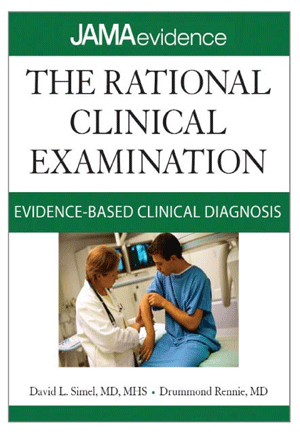Book review: The Rational Clinical Examination

The Rational Clinical Examination. By David Simel, MD and Rennie Drummond, MD. Whitby: McGraw-Hill Ryerson, 2008. ISBN: 978-0-07-159030-3. Paperback, 500 pages. $75.95.
The Rational Clinical Examination is a well-known series of articles used by many clinicians and trainees. The series has been published in JAMA since the early 1990s, and uses the best available evidence to answer common clinical questions.
Each article assesses how well our clinical findings on history and physical examination might predict a diagnosis such as pneumonia or clinical depression. Now these articles have been updated and compiled into a very readable text. Each chapter of the text begins with an original JAMA article and then explores any new evidence produced since its publication.
The authors use colorful tables to present likelihood ratios, treatment recommendations, and complete references from the primary literature.
I liked this book for several reasons. First, it is a very practical reference text. The editors look at common questions that often arise in clinic. Is this patient allergic to penicillin? Does this child have otitis media? Will my patient fall? It can be challenging for new learners to be sure of our diagnoses and then produce comprehensive treatment plans. This book helps us along and provides us with strong evidence to impress on the wards.
Second, the articles are short and well written. There are nice additions to the original JAMA articles such as text boxes with clinical correlations and helpful hints. Third, the layout is attractive. And finally, the text offers a great web site with PowerPoint slides and a teacher’s guide that would be especially useful for attendings or residents planning teaching sessions.
I have very few criticisms of this book. It is expensive, especially given that the complete set of original articles is available online at no cost. I would have liked to see even more pictures and figures in this text. The font can be small, and some of the statistical analyses are too dense for me. But overall I believe this is a worthwhile read.
This text will appeal to anyone with an interest in evidence-based medicine. It is probably most useful to senior medical students and to clinicians in primary care specialties such as family medicine, internal medicine, and pediatrics. Overall, this is a valuable, but maybe not essential, addition to any medical library.
—Laura Weingarten, BA
UBC Medicine Class of 2010
